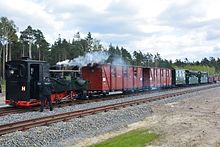Muskau Forest Railway
| Muskau Forest Railway | |||||||||||||||||||||||||||||||||||||||||||||||||||||||||||||||||||||||||||||||||||||||||||||||||||||||||||||||||||||||||||||||||||||
|---|---|---|---|---|---|---|---|---|---|---|---|---|---|---|---|---|---|---|---|---|---|---|---|---|---|---|---|---|---|---|---|---|---|---|---|---|---|---|---|---|---|---|---|---|---|---|---|---|---|---|---|---|---|---|---|---|---|---|---|---|---|---|---|---|---|---|---|---|---|---|---|---|---|---|---|---|---|---|---|---|---|---|---|---|---|---|---|---|---|---|---|---|---|---|---|---|---|---|---|---|---|---|---|---|---|---|---|---|---|---|---|---|---|---|---|---|---|---|---|---|---|---|---|---|---|---|---|---|---|---|---|---|---|
| Gauge : | 600 mm ( narrow gauge ) | ||||||||||||||||||||||||||||||||||||||||||||||||||||||||||||||||||||||||||||||||||||||||||||||||||||||||||||||||||||||||||||||||||||
|
|||||||||||||||||||||||||||||||||||||||||||||||||||||||||||||||||||||||||||||||||||||||||||||||||||||||||||||||||||||||||||||||||||||
| Weißwasser – Ruhlmühle | |||||||||||||||||||||||||||||||||||||||||||||
|---|---|---|---|---|---|---|---|---|---|---|---|---|---|---|---|---|---|---|---|---|---|---|---|---|---|---|---|---|---|---|---|---|---|---|---|---|---|---|---|---|---|---|---|---|---|
|
|||||||||||||||||||||||||||||||||||||||||||||

The Muskau Forest Railway (WEM) is a narrow-gauge railway with a gauge of 600 mm located in the Free State of Saxony .
history
Start time
The Muskau landlord, Count Hermann von Arnim, had a horse-drawn tramway with a gauge of 600 mm built in 1895 to develop the forests and raw material deposits in the area around Muskau and Weißwasser . In addition, the resulting industrial operations (lignite mines, brickworks, sawmills, paper factories and glassworks) should be connected to the rail network. The first two steam locomotives were purchased as early as 1895. By the turn of the century, the track network had grown to around 50 km.
After the First World War , locomotives and rolling stock could be taken over from the stocks of the German Army Field Railway . The vehicles formed the backbone until the railway ceased operations. A number of locomotives have been preserved to this day and are now also running on other museum field railways. The cars were rebuilt in the company workshop, e.g. B. to coal and clay wagons. In 1939 the WEM had 11 steam and several diesel locomotives, as well as over 550 wagons.
After the Second World War
The first time after the Second World War was very difficult due to damage to the tracks , vehicles and surrounding businesses, as well as reparations. Due to the lack of commercial vehicles , the WEM was irreplaceable for the reconstruction of the industry in the Weißwasser district . In 1951, the Deutsche Reichsbahn took over the facilities and operations in the GDR .
Profitability analyzes at the beginning of the 1970s questioned the profitability of the railway, but in 1966 the new line to the Mühlrose clay pit went into operation. Thereafter, operations were discontinued in sections by the Deutsche Reichsbahn until the end of the 1970s. A 12 km long remnant between the clay pit and the Weißwasser brickworks continued to be operated with type V10 C diesel locomotives .
From 1984 an association began to receive certificates from the former forest railway. Special trips on the clay railway were also started. After the brickworks were closed in 1990, the newly founded Waldeisenbahn Muskau e. V. the route. With the help of the Weißwasser district office , the railway was rebuilt as a tourist attraction. In 1992 the Weißwasser - Kromlau line went back into operation, followed in 1995 by the Weißwasser - Bad Muskau line .
Today the museum railway is the largest in 600 mm gauge in Germany.
Dismantling and replacement
As a result of the advancing Nochten opencast mine , a train last ran on the clay railway line from Weißwasser to the Mühlrose wagon transfer point on September 8, 2013 . In 2014, the route was dismantled after the Trebendorf water point from the edge of the opencast mine ( ) to the clay pit.
![]()
As a replacement, an alternative route was built along the edge of the opencast mine to the communication and nature conservation center Weißwasser Turm on Schweren Berg and opened on April 13, 2017.
vehicles
The first steam locomotive , the three-axle tank locomotive GRAF ARNIM was in 1895 Krauss in Munich built. In the 1930s this locomotive was given a tender to increase the range of the machine . Two identical machines were purchased in the following years. These vehicles were taken out of service before 1945, while GRAF ARNIM, last as 99.3301, was used on the island network in the south of Weißwasser until 1966.
In 1912 a four-axle tank locomotive was procured, which was named DIANA . It was a type supplied by Borsig to various railways.
A three-axle locomotive with trailing axle , which was procured from Krauss in 1919 and which was named ELEFANT, remained in service until 1945 and then went to the USSR as a reparation .
From 1921 four-axle brigade locomotives were procured for the Heeresfeldbahnen , which took over most of the traffic. Five of them came to the DR, which in turn acquired three more of these locomotives from other railways.
Today's forest railway Muskau GmbH currently has even more steam locomotives and diesel locomotives, among other types of Ns 1, Ns 2 and Ns3, and the type V10 C .
gallery
Steam train with the locomotive 99 3317
Departure of the forest railway in Bad Muskau
Coordinates: 51 ° 32 '16.8 " N , 14 ° 43' 22.8" E
Individual evidence
- ↑ The route to Mühlrose. Muskau Forest Railway, accessed on November 17, 2015 .
- ↑ Free travel to the Schweren Berg in Weißwasser. Radio Lausitz, April 13, 2017, accessed on April 13, 2017 .
literature
- Friedemann Tischer: Chronicle of the Counts of Arnimschen Kleinbahn Waldeisenbahn Muskau; Articles about local history for Weißwasser and the surrounding area - Volume 3 . Self-published, Weißwasser 2018.
- Wilfried Rettig: The GDR narrow-gauge railways 1965 - 1990; A quarter of a century: numbers, data, facts . EK-Verlag, Freiburg 2018, ISBN 978-3-8446-6412-6 .



